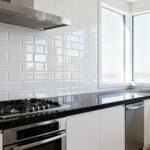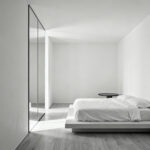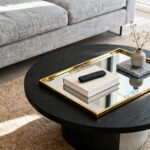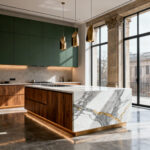Designing a bedroom is, at its heart, an act of self-revelation—every choice reflects not just aesthetic preference, but deeper values about how life should be lived in its quietest moments. The most compelling private spaces aren’t merely decorated; they are authored. They tell a coherent story about their inhabitants’ understanding of comfort, beauty, and tranquility’s role in daily life. These twenty principles separate a bedroom that feels truly authentic from one that simply looks expensive.
For those of us who appreciate lasting quality, the process of selecting a wallpaper begins long before we look at a single sample. It starts with an idea, a feeling, a vision for the space. We will begin by exploring the conceptual foundations that govern aesthetic resonance—how color and pattern speak a subliminal language of comfort. From there, we will move into the world of tactile opulence, learning the connoisseur’s guide to materials like silk, grasscloth, and artisanal hand-blocked papers.
The next step is to architect the room’s atmosphere, using wallpaper not just as a covering but as a tool to manipulate light and space. We’ll examine how strategic placement can create illusions of grandeur and define the very architecture of your haven. Finally, we will transcend aesthetics to position your wallpaper choice as an instrument of well-being and a sound long-term investment.
Through this carefully curated lens, your bedroom can be transformed into a uniquely personal sanctuary—a testament to where timeless design and true comfort converge.
Cultivating Conceptual Foundations: The Axioms of Aesthetic Resonance
Before a single roll is ordered, we must first speak the language of design itself. These initial principles are the foundation upon which all other choices are built. They guide us toward creating a room that doesn’t just look right but feels profoundly so, ensuring the final result is both beautiful and deeply resonant.
1. Mastering Chromatic Harmony for Subliminal Well-being
A bedroom’s color palette is its emotional architecture. In my years of high-end interior design, I’ve learned that the most successful spaces begin not with a style, but with an intended feeling. Color Theory isn’t just academic; it’s the primary language we use to articulate that feeling. Warm tones like blush or muted ochre create an enveloping, cocoon-like atmosphere, while cooler shades—serene blues, soft sages—evoke a sense of calm and expansiveness. A wallpaper choice isn’t just about selecting a color; it’s about composing a physiological state.

Think, too, about how the material will hold that color. A matte finish on a non-woven paper absorbs light, deepening a hue’s richness and creating an intimate mood. A hint of metallic thread woven into a grasscloth, however, catches the light and lends a subtle luminosity. You must consider the room’s natural light. North-facing rooms benefit from warmer tones to balance the cool light, whereas sun-filled rooms can handle cooler colors beautifully without feeling stark. The goal is a subtle symphony that supports rest, not one that shouts for attention.
2. Decoding Pattern Dynamics for Enduring Serenity
Once you’ve established an emotional palette with color, the pattern introduces rhythm and narrative. Our response to pattern is deeply ingrained. Biophilic designs—those that mimic nature through botanicals, gentle waves, or organic textures—tap into our innate connection to the natural world, fostering a genuine sense of peace. You can almost feel your blood pressure drop. In contrast, geometric rhythms offer structure, order, and a modernist appeal to the part of our psyche that craves clarity and precision.

What I tell my clients is that the scale of the pattern is just as important as the motif itself. A large-scale botanical can feel immersive, almost like a mural, turning a feature wall into a transportive piece of art. A smaller, tightly repeated geometric, on the other hand, can feel more like a texture from a distance, creating a cozy, enveloping effect perfect for all four walls. This choice is a reflection of temperament. Do you recharge with the free-flowing calm of a garden or the quiet order of architecture? The right pattern dynamic ensures the room’s enduring serenity.
3. Aligning with Timeless Design Epochs
Selecting a wallpaper with historical resonance is like adding a beautiful, soulful layer to your room’s story. It’s about choosing a style that has already stood the test of time, ensuring your space feels classic, not dated. Whether you’re drawn to the flowing, organic lines of Art Nouveau, the bold symmetry of Art Deco, or the honest craftsmanship of the Arts & Crafts movement, aligning with a design epoch lends an immediate sense of character.

The key is to integrate these historical motifs authentically, not to create a museum replica. For example, a grand Toile de Jouy can look magnificent in a traditional bedroom with high ceilings, while just a single panel of a mid-century abstract design can act as a powerful art piece in a more minimalist space. I’ve seen this work best when the wallpaper serves as the cohesive thread that unites the architecture, furniture, and lighting. It ensures the bedroom becomes a testament to cultivated taste that speaks to design principles far deeper than fleeting trends.
4. Cultivating Visual Tranquility with Scale and Repetition
The psychological comfort of a room is quietly dictated by the scale and repetition of its patterns. Our minds instinctively seek harmony, and the size of a motif—and how often it repeats—can make a room feel expansive, intimate, or chaotic. A wallpaper with a large-scale pattern and plenty of negative space can create a sense of grandeur and openness, even in a smaller room. It draws the eye and gives it somewhere to rest.

Conversely, a small-scale, densely packed pattern can lend a cozy, jewel-box intimacy, which is wonderful for creating a sanctuary-like feel. In my professional experience, manipulating a room’s perceived dimensions is one of the most powerful tools in a designer’s arsenal. A vertical stripe or climbing floral will always draw the eye upward, giving the illusion of a higher ceiling. This mindful calibration of scale ensures your wallpaper actively contributes to an environment of profound psychological comfort.
5. Establishing a ‘Genius Loci’ Through Pattern Storytelling
The Romans had a term, genius loci, for the protective spirit of a place. In design, we create this spirit by curating a thematic narrative. Your bedroom wallpaper can be the primary storyteller, its pattern a verse that speaks to your personal journey, an aspiration for calm, or a cherished memory. This is where a bedroom moves beyond being well-designed and becomes deeply personal.

The material itself is part of the story. A hand-painted chinoiserie on silk speaks of exoticism and delicate beauty, while a textured linen with a subtle geometric tells a tale of modern, structured serenity. Is your story one of immersive nature, told through a panoramic botanical mural behind the headboard? Or is it a quieter narrative, whispered by a tone-on-tone damask that envelops the entire room? When your wallpaper reflects your inner world, the bedroom ceases to be just a room. It becomes a true extension of self.
Embracing Tactile Opulence: A Connoisseur’s Guide to Wallpaper Substrates
True luxury is often felt as much as it is seen. The substrate—the material of the wallpaper itself—is a fundamental component of its character. It dictates how the paper hangs, how it interacts with light, and how it feels to the touch. This is where a discerning eye separates the ordinary from the extraordinary.
6. The Sensorial Depth of Silk, Linen, and Grasscloth
There is an authenticity to natural fibers that simply cannot be replicated. Choosing silk, linen, or grasscloth is an investment in character, texture, and understated luxury. Silk wallcoverings have a luminous quality, their subtle sheen casting a soft, flattering glow that shifts beautifully with the light. They are unapologetically elegant. Linen, by contrast, offers an earthy sophistication. Its characteristic slubs and matte finish absorb light, creating a serene, calming effect that feels both relaxed and refined.

But it’s grasscloth that offers the most dimensional experience. Crafted from fibers like jute or sisal, it is meticulously woven and laminated onto a paper backing. Every panel is unique. In my practice, I find clients are drawn to its organic, architectural quality. It adds instant warmth and has the added benefit of dampening sound, contributing to a quieter, more peaceful environment. These materials aren’t just wallcoverings; they are tactile experiences.
7. The Innovation of Non-Woven and Vinyl Substrates
Modern advancements have given us materials that blend high aesthetics with practical performance, and frankly, this is where smart investments are often made. Non-woven wallpapers, typically a blend of natural and synthetic fibers, are dimensionally stable—meaning they won’t shrink or expand on the wall. They are breathable, which helps prevent mildew, and the “paste the wall” application makes for a much cleaner installation. It’s a choice that respects both quality and convenience.

Vinyl substrates, once relegated to commercial spaces, have become incredibly sophisticated. High-end vinyl can replicate the texture of fine linen, raw silk, or even suede with astonishing realism, all while offering unparalleled durability and washability. For a busy home or simply for peace of mind, a beautifully rendered vinyl offers robust beauty. This is about choosing a material that fits your lifestyle without compromising on the luxurious feel you desire.
8. The Bespoke Grandeur of Hand-Blocked and Embroidered Wallcoverings
In an age of mass production, there is nothing more luxurious than the human touch. Hand-blocked and embroidered wallpapers are the haute couture of the design world. With hand-blocking, each repeat of the pattern is applied with a carved wood block, leaving subtle variations in color and alignment. This ‘perfect imperfection’ is what gives the paper its soul. It tells the story of its creation right there on your wall.

Embroidered wallcoverings take this to another level, introducing actual physical texture with thread stitched onto a fabric backing. These are essentially textile art for your walls. The interplay of light across the different sheens of thread creates a dynamic, soft, and unbelievably decadent surface. What I tell my clients is this: If you want your bedroom to feel truly one-of-a-kind, investing in a single wall of an artisanal paper can have more impact than a room full of ordinary furniture.
9. The Alchemy of Gilded and Iridescent Surfaces
Light is the final ingredient in any design, and metallic or iridescent wallpapers are masters at manipulating it. These surfaces turn a static wall into a living canvas that changes throughout the day. Gilded papers, with foils or inks in gold, silver, or bronze, catch and amplify ambient light, making a room feel more luminous and grand. They are especially effective in rooms that need a bit of warmth or glamour, casting an inviting glow in the evening light.

Iridescent surfaces offer a softer, more ethereal magic. Using pearlescent pigments, they create a shimmering, multi-tonal effect that subtly shifts with your viewing angle, much like the inside of a seashell. This isn’t about bold reflection but a gentle, atmospheric luminescence that seems to emanate from within the paper itself. It’s perfect for creating a dreamy, tranquil space that feels both sophisticated and subtly enchanted.
10. The Wisdom of Eco-Conscious Materials
True luxury today is inseparable from sustainability. A truly serene sanctuary must also be a healthy one. This means specifying eco-conscious materials, such as papers from managed forests or those made from recycled content, and insisting on water-based inks free of heavy metals. This commitment to provenance ensures that beauty is not achieved at the expense of our well-being or the planet’s.

Even more critical is the choice of adhesive. Many standard adhesives contain Volatile Organic Compounds (VOCs), which off-gas into the air and compromise indoor air quality. I learned early in my career that specifying zero-VOC or ultra-low-VOC adhesives is non-negotiable for a healthy home, especially in a bedroom where we spend so much of our time. This thoughtful approach defines the modern connoisseur, creating a space where peace of mind is the ultimate luxury.
Architecting Ambience: Strategic Placement and Illusory Expansion
Wallpaper is not merely applied; it is placed with intention. A masterful design uses wallcoverings as an architectural tool to define zones, play with light, and manipulate the perception of space. This is where technique elevates a beautiful product into a transformative design element.
11. Defining Spatial Volumes with Architectural Dialogue
Think of your walls not as simple boundaries but as active participants in the room’s architecture. Wallpaper can be used to engage in a dialogue with the space, enhancing its best features and giving it structure. A bold, large-scale pattern can lend weight and importance to a feature wall, while a subtle, textured grasscloth can make a room feel larger by adding depth without closing it in.

You can also use wallpaper to articulate zones within a larger master suite. I often use this technique to create a distinct sitting area or dressing space without building a single wall. By applying a unique paper within that alcove or section, you create a ‘room within a room’—a subtle and elegant demarcation. It’s about using pattern and texture to choreograph the way you experience the space, making it both more functional and more visually interesting.
12. Harnessing Light with Reflective and Absorbent Surfaces
How a wallpaper interacts with light is fundamental to a bedroom’s ambiance. This is a technical choice as much as an aesthetic one. Papers with metallic or silk-like sheens act as gentle mirrors, bouncing light around the room to make it feel brighter and more expansive. They can bring a cool, north-facing room to life.

Conversely, matte textures like linen, velvet, or untextured grasscloth absorb light. Why would you want that? In a bedroom that gets harsh, direct sun, an absorbent surface can soften the glare and create a far more soothing, intimate atmosphere. It reduces visual noise. The choice depends entirely on your room’s natural light and the mood you want to cultivate—a bright awakening or a dark, cozy retreat.
13. Creating Illusions of Grandeur with Verticals, Horizontals, and Murals
This is where we engage in a little bit of design magic. Through clever pattern selection, you can completely change the perceived proportions of a room. Vertical stripes or patterns with a strong upward movement—like climbing vines or tall trees—will instantly make a ceiling feel higher. It’s the oldest trick in the book, and it works every time. A horizontal pattern can make a narrow room feel wider and more spacious.

For the ultimate illusion, consider a mural. A panoramic landscape can dissolve a wall entirely, making the room feel boundless. Even an abstract mural can create a sense of depth and artistry that elevates the entire space. It transforms the wall from a simple surface into a destination, lending a sense of bespoke grandeur that is deeply personal and visually stunning.
14. The Power of the Curated Accent Wall
The principle of the accent wall is often misunderstood. It is not about saving money; it is about creating focus with surgical precision. By designating a single wall—typically the one behind the headboard—for a dramatic, high-impact wallpaper, you anchor the room and create a powerful statement. This allows you to indulge in a truly spectacular paper—perhaps a hand-painted de Gournay scene or a richly embroidered textile—without overwhelming the space.

This technique is the epitome of restraint and confidence. The feature wall becomes the centerpiece, a piece of art that frames the most important element in the room: the bed. The other walls can then be painted in a quiet, complementary color drawn from the wallpaper, creating a balanced and cohesive design. It’s a declaration that in design, as in life, choosing where to place your focus is everything.
15. Navigating Architectural Nuances with Precision
A room with architectural oddities—dormers, alcoves, sloped ceilings—is not a challenge, but an opportunity. Applying wallpaper flawlessly in these areas is a mark of true craftsmanship and elevates the entire design. In fact, these are the moments I often choose to highlight. Wallpapering the inside of an alcove can turn it into a charming, jewel-box moment. Continuing a pattern up into a dormer makes the feature feel intentional and integrated.

Success here is all about precision. The pattern must align perfectly as it turns corners and navigates angles, creating the illusion that it flows effortlessly across every surface. This requires meticulous planning and, often, a professional installer. The result is a bedroom that feels custom-built and thoughtfully considered, where every architectural detail is celebrated rather than ignored.
Transcending Aesthetics: Wallpaper as an Instrument of Well-being and Longevity
The final layer of sophisticated design considers the human element—how a space fosters well-being and adapts over time. A wallpaper choice should not only be beautiful on day one but should also contribute to a life well-lived and stand as a smart, enduring investment.
16. Fostering a Personal Sanctuary for Cognitive Clarity
The primary function of a bedroom is restoration. Your wallpaper choice can either support or undermine this function. To foster a true sanctuary, we must choose patterns and colors that promote serenity and cognitive clarity. What does that mean in practice? It means avoiding patterns that are visually jarring or overly stimulating. High-contrast, busy motifs can create a subtle, subconscious sense of chaos that is antithetical to rest.

Instead, gravitate toward designs with a gentle visual rhythm—soft, biomorphic forms, subtle tone-on-tone textures, or spacious patterns that allow the eye to rest. Materials like grasscloth or linen that diffuse light softly also contribute to a calmer environment. In my luxury design correspondent practice, I always guide clients to consider how a pattern will make them feel after seeing it every single day. The goal is to create a quiet visual backdrop that allows your mind to truly unwind.
17. Designing for Evolvability with Demountable Formats
Timeless design should also be adaptable. Life changes, and our homes should be able to evolve with us. This is where demountable and high-quality peel-and-stick wallpapers have become an incredibly smart choice. These are not the flimsy decals of the past; modern removable papers offer sophisticated textures and patterns on durable, non-woven substrates that can be removed cleanly, without damaging the walls.

This innovation allows for incredible freedom. It’s a perfect solution for a child’s room that will need updating in a few years, or for those of us who simply enjoy refreshing our environment seasonally. It represents a more fluid and sustainable approach to design, reducing waste and allowing your space to remain a perfect reflection of you, right now. It is a choice that embraces both beauty and pragmatism.
18. Harmonizing with Concealed Technologies
In a modern luxury home, technology should be felt, not seen. The bedroom, in particular, should be a refuge from blinking lights and visible hardware. Wallpaper can be a brilliant ally in this quest for seamless integration. Acoustic wallpapers can cleverly conceal in-wall speakers while improving the room’s sound quality, and papers with subtle, non-reflective textures are excellent for camouflaging smart home control panels or wireless charging pads.

This extends to lighting. As we embrace biometric lighting systems that attune to our circadian rhythms, the wallpaper’s finish becomes critical. Will its surface enhance the warm, soft glow of an evening setting, or will it create glare? The goal is to create a technologically advanced sanctuary where cutting-edge function operates in quiet harmony with the room’s curated beauty, never detracting from the overall sense of peace.
19. Mitigating Common Misapplications for Enduring Elegance
Even the most expensive wallpaper in the world will look cheap if improperly applied. Enduring elegance hinges on technical excellence. One of the most common mistakes I see is a pattern scale that is completely wrong for the room—a tiny print lost in a grand space, or a massive motif that overwhelms a small room. Proportion is everything. The pattern must be in harmony with the room’s volume and the scale of the furniture within it.

The other critical detail is pattern alignment. A professional installer is an investment, not an expense. They ensure that the design flows seamlessly across every panel and turns corners gracefully, avoiding awkward cuts or mismatched seams. These technical details are not minor—they are the foundation upon which a truly sophisticated design is built. Getting them right ensures your investment yields lasting satisfaction and timeless appeal.
20. The Long-Term Stratagem for Investment and Resale Value
Finally, always view your wallpaper choice through the lens of a long-term investment. A well-designed bedroom featuring high-quality, classic wallpaper significantly enhances a home’s perceived value. It signals to potential buyers a level of care, quality, and sophistication that extends throughout the property. Choose patterns and materials that have enduring appeal over fleeting trends. Classic stripes, elegant damasks, natural textures, and timeless botanicals are always wise choices.
Equally important is ensuring the paper can be maintained. High-quality non-woven or vinyl papers are surprisingly durable and easy to clean, protecting your investment for years. This strategic approach ensures your bedroom is not just a personal oasis but also a valuable asset. It’s the ultimate expression of smart design: a choice that enriches your daily life while also appreciating in value.
Conclusion
Our exploration through the principles of bedroom wallpaper design reveals a clear truth: this choice is far more than simple decoration. It is a thoughtful composition of color, texture, and light, designed to create a personal sanctuary that nurtures the soul. We have seen how a wallcovering can alter our perception of space, tell a story of timeless elegance, and serve as a quiet instrument for our well-being.
The philosophical heart of exceptional design lies in this power of intention. To select a wallpaper for your bedroom is to engage in a profound act of self-care and personal expression. It’s an investment in the quality of your rest, your peace of mind, and the enduring beauty of your home. I encourage you not to merely adorn your walls, but to curate them, choosing a design that resonates deeply with your personal narrative.
May your final choice be more than a beautiful backdrop. May it be a deliberate and lasting ode to comfort, an ever-present whisper of peace, and a testament to the art of living beautifully within your own thoughtfully composed space.










